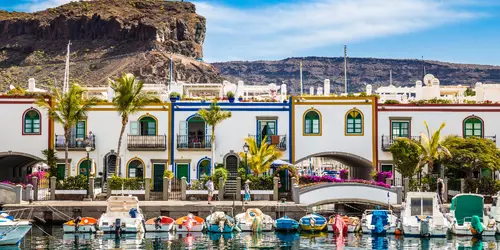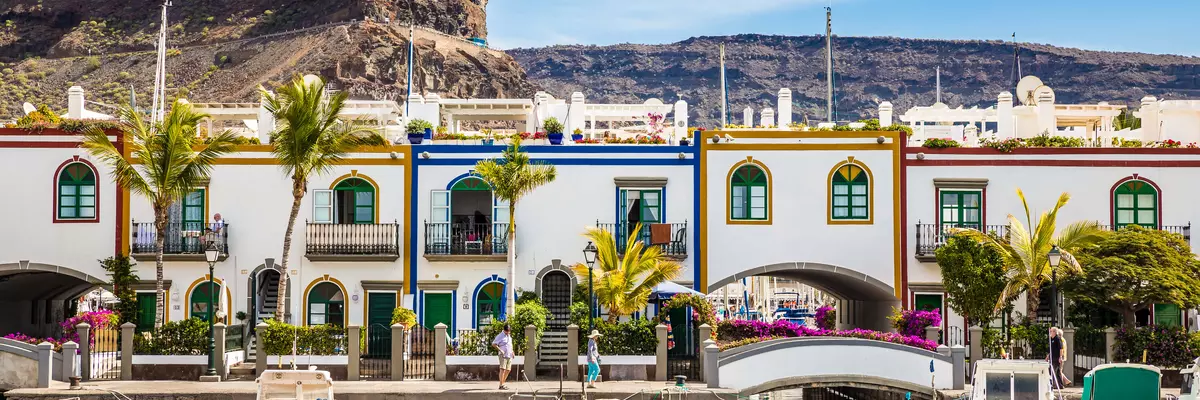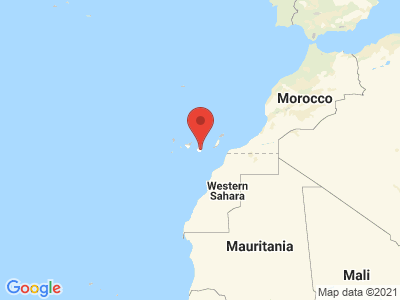Climate Table Gran Canaria
Jan | Feb | Mar | Apr | May | Jun | Jul | Aug | Sep | Oct | Nov | Dec | |
|---|---|---|---|---|---|---|---|---|---|---|---|---|
| Max. Temperature | 21° | 22° | 22° | 22° | 23° | 24° | 25° | 26° | 26° | 26° | 24° | 22° |
| Min. Temperature | 14° | 14° | 15° | 16° | 17° | 18° | 19° | 21° | 21° | 19° | 18° | 16° |
| Sun Hours | 6 | 6 | 7 | 8 | 9 | 9 | 9 | 9 | 8 | 7 | 6 | 5 |
| Water Temperature | 19° | 18° | 18° | 18° | 19° | 20° | 21° | 22° | 23° | 23° | 21° | 20° |
| Rain Days | 6 | 3 | 3 | 2 | 1 | 1 | 1 | 1 | 1 | 4 | 6 | 6 |
The climate year of Gran Canaria
Gran Canaria is the third largest of the off west coast of Africa lying Canary Islands, which are of volcanic origin. Due to the Canary current, an ocean current of the Atlantic Ocean, and the nearby equator, the temperatures here are uniform, varying only 10 degrees on an annual average. It is mild in winter and not too hot in summer. The south of the island is rather dry and barren, the north much greener and more forested. In the interior of the island you can find impressive mountain landscapes up to almost 2000 meters high. The highest point of the island is the Pico de Las Nieves with 1949m. On the extinct volcano it snows even sometimes in winter. From here you have a breathtaking view over the island to the sea, in clear weather to the neighboring island Tenerife and the highest mountain Spain, the Pico del Teide. The 1813m high Roque Nublo (Cloud Rock) is the landmark of the island of Gran Canaria.
General information about Gran Canaria
The sights are very diverse. World famous are the dunes of Maspalomas in the south. The fine yellow sand is piled up like meter-high waves. Towards the sea, the dunes merge into flat, wide beaches. The flat coastal landscapes rise steeply toward the center, giving an impressive view of deep valleys or rock faces. The picturesque fishing village of Puerto de Mogán, for example, lies idyllically by the sea. A few kilometers later you reach altitude and enjoy fantastic views from a plateau. The Barranco de Guayadeque invites you into the past of Gran Canaria, here people still live in caves like the natives. Equally vivid is the archaeological open-air museum Mundo Aborigen. Not to forget the beautiful places of the island - first of all the capital Las Palmas with its historical old town, the spacious harbor and the beautiful city beach Las Canteras. In the religious small town of Teror you will find many testimonies of typical Canarian architecture. And the plant lover is recommended to visit one of the botanical gardens.
Tourism Gran Canaria
Gran Canaria's climate is strongly influenced by the trade winds that come from the northeast. Moist clouds rise through the mountains in the interior of the island, so the north of the island experiences sometimes abundant precipitation, mostly as fog. The south is turned away from the trade winds, so it is very dry. In addition, there are dry winds from the Sahara region. This weather situation, known as calima, brings sandstorms to the island, and temperatures rise sharply. Because of its climatic and geographical diversity, as well as its rich flora and fauna, Gran Canaria is often called a "miniature continent". Gran Canaria has 14 microclimatic zones and throughout the year the daytime temperatures oscillate only between 21 and 26°C. The main season on the island is from October to March, during which time many northern and central Europeans spend their vacations on Gran Canaria. In October the sea is warmest, heated up by the sun. After that it cools down a bit, although it is bathing season all year round with constant water temperatures. January is on average the coolest month, August to October is the warmest, at night it cools down only a few degrees.


